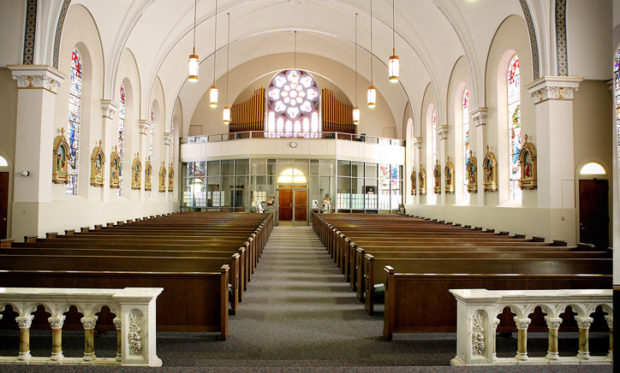Catholicism of the future – a minority church?

“By 1605… the Filipinos have been overwhelmingly Catholic in numbers, and they remain so today” (Dr. Edward Gaylord Bourne, 1860-1908).
In Manila, on January 19, 2015, Pope Francis celebrated the largest Holy Mass in history, with over 6 million in attendance. Filipino Catholics keep on breaking records in world religions. The annual traslacion of the Black Nazarene is now one of the biggest historic peaceful gatherings of people in one place for a single event.
However, many serious believers raise the “Quintessential Question of Quality over Quantity” (QQQQ): Is a bigger Church a stronger and a better Philippine Church, where “parishes are often seen as sacramental filling stations, (and) where people come for the Eucharist, baptisms, marriages and funerals, but little else” (John L. Allen, Jr).
During conferences and travels, I get to meet and admire our Catholic brethren in South Korea, Vietnam, Singapore, Hong Kong, Taiwan or in predominantly Muslim Malaysia and Indonesia. They are the minority, a drop in the ocean of non-Christians, and yet so edifying and inspiring in word and deed.
As the community of believers headed by Jesus Christ (Colossians 1:18) and propagated by His Apostles about 2,000 years ago, the one, holy, Catholic, and Apostolic Church is the biggest Christian Church in the world.
With the universal commissioning “Go to all the world and preach the Good News” (Mark 16:15) apparently fulfilled, Christians are geographically widespread, with 1.4 billion Catholics living in every nook and corner of the globe. But is a majority Church a better Church?
The rise of the Cafeteria and non-practicing Catholics, and doubters
In 1987, Saint John Paul II opened up his aching heart: “A large number of Catholics today do not adhere to the teaching of the Catholic Church on a number of questions, notably sexual and conjugal morality, divorce and remarriage… (and) abortion.”
Cafeteria Catholics allege that the Catholic Church is antiquated like a manual Seiko watch in the age of smart phones and AI. Our Polish pontiff lamented the tendency on the part of some Catholics to be selective in the practice of the Faith, who also claimed that dissent from the Magisterium is totally compatible with being a “good Catholic.”
Even in Italy, which is called the Pope’s Garden, practicing “good” Catholics number only between 8 and 15 percent.
I don’t believe in Heaven and Hell,” George Clooney once said, “I don’t know if I believe in God.” Raised with deeply practicing Catholic roots, George Clooney has outgrown his childhood religion. And not just Hollywood stars George Clooney, Guillermo del Toro, Kevin Bacon, Javier Bardem, former Speaker Alvarez, President Duterte, and Robin Padilla (now a Muslim), but also a million more other Catholics have turned into doubters, atheists, or born-again Christians.
Clergy: The devil’s bullseye
As an aftershock of clerical abuse scandals, Catholic Ireland is practically unrecognizable today. It has legalized abortion, divorce, contraception, and same-sex marriage to break away from its Catholic tradition.
The recent Pennsylvania abuse report was a stomach-turning chronicle of evil inflicted upon a thousand innocent people by some 300 “criminal and morally reprehensible” predator-priests.
His back never broken and his fiendish desire unsatisfied, it seems the Devil drools to see our bishops, priests, and all coadjutors of the Pope decimated or at least crippled. His methods are clear cut: Divide them, assassinate some, destroy priestly vocation, and hit them hard in their vulnerability.
The Lord of Lies from the Inferno’s main target is the clergy. Why? Because the Holy Priesthood is “the nerve center of the Church’s whole life and mission” (John Paul II, October 27, 1995).
Once the Catholic Church’s credibility hits the rock bottom, the consequences are the scarcity of priests and dwindling vocation to the religious life, empty pews and empty altars — so much experienced in North America, Australia, and Europe – and some huge cathedrals turned into museums. Some people believe that the way of purification has begun.
“Do not be afraid,” says the Lord. When the Catholic Church is reduced into a smaller community, less identified with super societies, with no socio-political power to boast, shamed and persecuted, the images once portrayed by Pope Emeritus Benedict XVI come to mind: “Small, vital circles… the mustard seed, the salt of the earth AGAIN” (Salt of the Earth: The Church at the End of the Millennium, 1997).
Shall I witness in my lifetime a Catholic Church with few but holy priests? Small parishes composed of a few but truly convinced believers who live their Catholic Faith and Morals twenty-four-seven? A vibrant Church more faithful to the Gospel, to Sacred Tradition, and to the Bishop of Rome?
Jose Mario Bautista Maximiano is the author of The Church Can Handle the Truth (Claretian, 2017). Comments to jomaximiano@gmail.com

